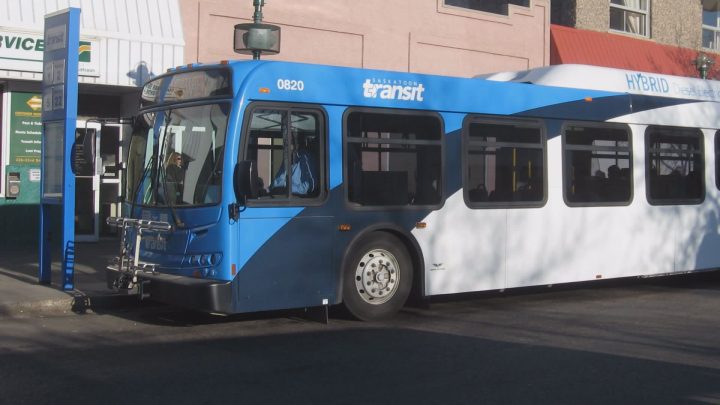Saskatoon bus riders will once again have to pay a fare come June 8, after payment was suspended as a pandemic measure in mid-March.

City council made the decision unanimously on Wednesday, also approving front-door loading and installation of temporary vinyl panels by the driver’s seats.
Physical distancing requirements have limited capacity on city buses to about 10 passengers, compared to the 60 they’re normally able to carry, according to a report from Saskatoon transit.
Since March 20, the front portion of buses have been sectioned off to protect drivers, who are equipped with masks and disinfectant.
Those barriers will be removed and replaced with clear vinyl panels on June 8, coinciding with the third phase of the reopen Saskatchewan plan.
The move will allow passengers to use the front door of the bus, which was previously prohibited and made fare payment impossible.
It will also free up three to five additional seats per bus.
While daily ridership dropped from about 40,000 riders to 1,000 riders in the early days of the pandemic, the transit report stresses the need to boost passenger capacity as the province reopens.
Demand has increased to about 6,000 daily riders during Phase two of the reopening plan. Saskatoon Transit director Jim McDonald expects it will increase further with Phase 3.
“We do recommend that everybody travelling wear a mask … and so that’s one of the ways we’re hoping to get to potentially have full-seated loads in the future.”
Meeting typical peak demand won’t be possible without masks or relaxed physical-distancing measures, the report says.
Mayor Charlie Clark said mask use may become more widespread as the the province continues to reopen.
“Starting to talk about that, providing that guidance, and building up that … awareness and the adjustment and the comfort with that is worthwhile,” Clark said.
“The conversation about that is really important and it’s one we’re going to have to go through as a whole community.”
Saskatoon Transit has taken a major financial hit because of the pandemic, with an estimated deficit of anywhere from $8.4 million to $10.3 million.
Once fares are reintroduced, Saskatoon Transit expects only 15 per cent of its regular revenue, largely due to distancing restrictions.
McDonald said Saskatoon Transit is working with the city’s chief financial officer to explore methods to make up for the deficit.
“The biggest worry that we have … is getting people back to transit,” McDonald said, “and then making sure that when we bring people back to transit, that we’re not stopping them from taking transit because we don’t have enough seats on our buses.”
Questions about COVID-19? Here are some things you need to know:
Symptoms can include fever, cough and difficulty breathing — very similar to a cold or flu. Some people can develop a more severe illness. People most at risk of this include older adults and people with severe chronic medical conditions like heart, lung or kidney disease. If you develop symptoms, contact public health authorities.
To prevent the virus from spreading, experts recommend frequent handwashing and coughing into your sleeve. They also recommend minimizing contact with others, staying home as much as possible and maintaining a distance of two metres from other people if you go out. In situations where you can’t keep a safe distance from others, public health officials recommend the use of a non-medical face mask or covering to prevent spreading the respiratory droplets that can carry the virus.
For full COVID-19 coverage from Global News, click here.





Comments